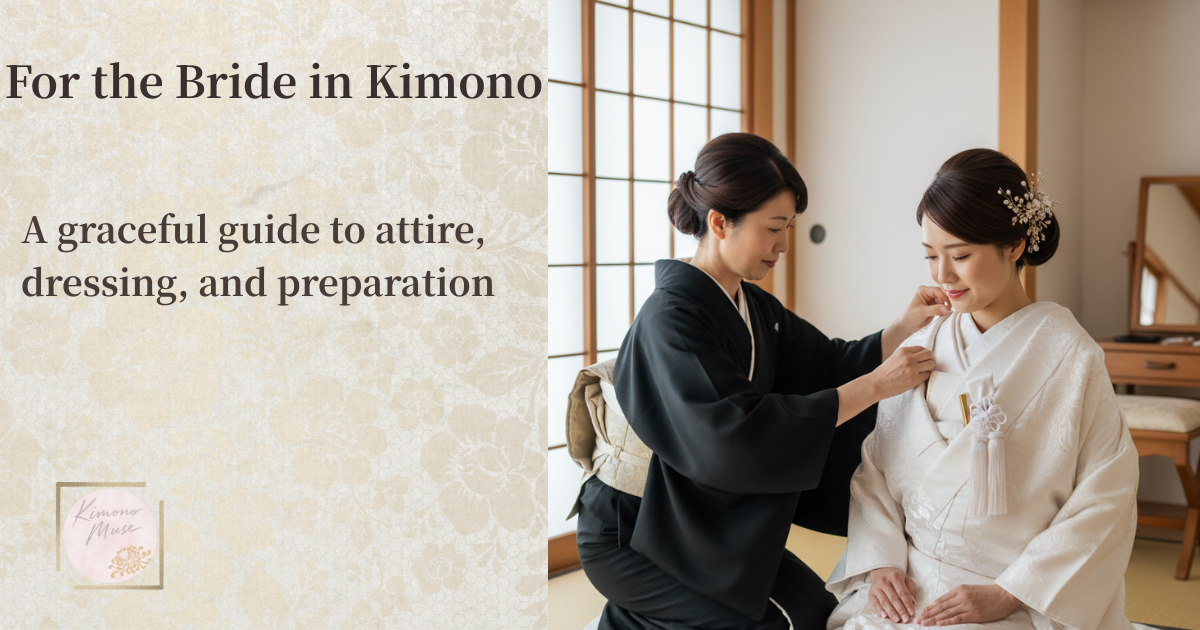Western wedding dresses are undeniably beautiful — yet for many Japanese brides, there is a deep longing to experience a traditional wedding in exquisite kimono at least once in a lifetime.
The serene purity of shiromuku, the radiant elegance of iro-uchikake, and the graceful hikifurisode worn only by brides — each style carries centuries of symbolism and artistry.
A Japanese kimono wedding is not only visually stunning; every step, every motif, and every layer of silk reflects tradition, respect, and hope for a new beginning.
Still, many brides wonder:
“Will traditional kimono suit me?”
“How much will it cost?”
This guide is here for you — for brides who are curious, inspired, yet perhaps a little unsure.
In the pages that follow, you will learn:
• The different types of bridal kimono and the meaning behind each design
• How to choose the style that feels truly “yours”
• Posture, movement, and beauty tips to shine in traditional attire
• Hidden costs and smart budgeting for a smooth wedding experience
Whether you’re planning a full traditional ceremony or simply dreaming of a kimono for your pre-wedding photoshoot, this guide will help you discover the beauty, history, and confidence found in wearing a Japanese bridal kimono.
May you find the one — the gown that feels like destiny, sewn with tradition and worn with grace.
Finding the Kimono That Feels Truly Yours
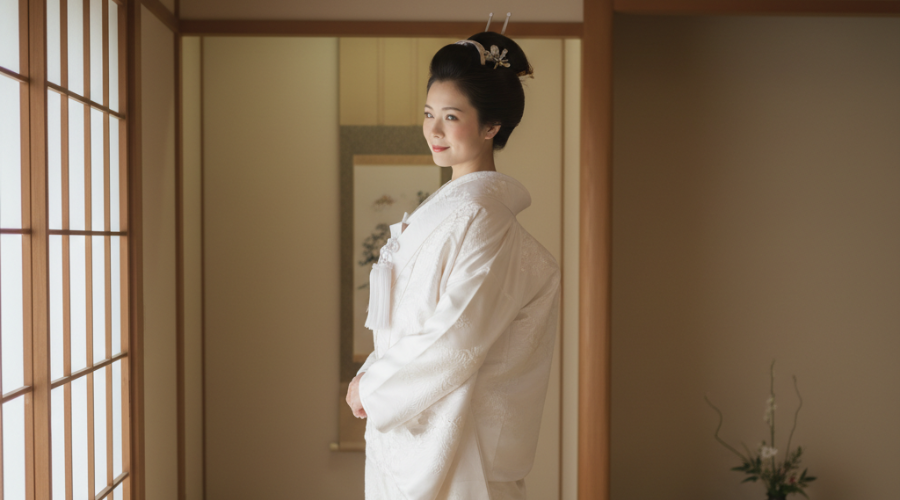
The success of a Japanese kimono wedding begins with one of the most meaningful choices you will make — your bridal attire.
In many ways, the entire atmosphere of the day is shaped by which kimono you choose.
From the pure elegance of the shiromuku, to the vibrant beauty of the iro-uchikake, and the graceful hikifurisode worn only by brides — each style has its own history, symbolism, and proper occasion.
For brides encountering kimono for the first time, the variety may feel overwhelming.
You may even find yourself wondering,
“Why are there so many types?”
In this section, we will guide you through:
• The main types of bridal kimono and their formality
• The lesser-known truth about hikifurisode vs. furisode
• Practical tips to help you find the style that truly suits you
By understanding the meaning behind each garment and how they are worn, you’ll be able to choose the kimono that feels authentic, beautiful, and perfectly aligned with your wedding vision.
The Three Essential Bridal Kimono Styles & Their Formality
In a traditional Japanese kimono wedding, brides typically choose from three main types of kimono, each with its own level of formality and symbolic role.
| Type | Features | Formality Level | Main Occasions |
|---|---|---|---|
| Shiromuku (All-white bridal kimono) | The most formal bridal kimono, entirely white to symbolize purity and new beginnings. | Highest | Wedding ceremony (Shinto or Buddhist), start of reception |
| Iro-uchikake (Colorful embroidered over-kimono) | Luxurious kimono with rich colors and elaborate embroidery. Same formal level as shiromuku. | High (same as shiromuku) | Reception, attire change, pre-wedding photos |
| Hikifurisode (Trailing long-sleeved kimono) | The highest-rank formal kimono for unmarried women; worn with the hem trailing and the obi visible. | High (same as shiromuku & iro-uchikake) | Reception, attire change, non-religious ceremonies |
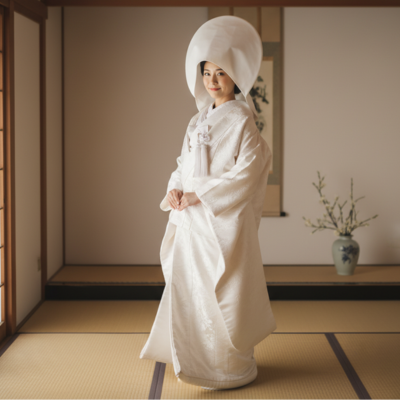
A bride in shiromuku, the pure white kimono symbolizing new beginnings and sacred purity. Traditionally worn for the wedding ceremony.

A radiant iro-uchikake with rich embroidery and vibrant colors, representing celebration and good fortune. Ideal for receptions and photo shoots.
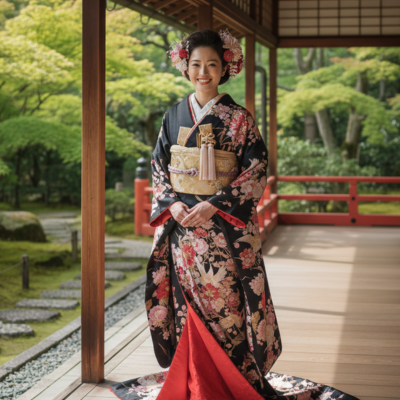
A graceful hikifurisode worn with the hem trailing and the obi on display. Elegant and youthful, traditionally the highest-formal kimono for unmarried women.
【Why Is the Shiromuku Considered the Most Formal Bridal Kimono?】
White has long been considered a sacred color in Japan, symbolizing purity and the bride’s readiness to “be embraced and harmonize with her new family.”
Because of this deep cultural meaning and its use in sacred ceremonies throughout history, the shiromuku is regarded as the highest-formal bridal attire.
Bridal Furisode vs. Coming-of-Age Furisode: What Makes Them Different?
Note: In Japan, the Coming-of-Age ceremony celebrates reaching adulthood at age 20. Many young women wear a furisode (long-sleeved kimono) for this occasion.
Many brides who choose kimono for their wedding are surprised to learn that there are different types of furisode — including special bridal styles such as hikifurisode and hon-furisode.
When you hear the word furisode, you may first picture the colorful kimono worn by young women at Japan’s Coming-of-Age ceremony, a celebration of adulthood at age 20.
However, the furisode worn by brides is on a completely different level in terms of formality and elegance.
Bridal furisode have longer sleeves and are considered the most formal style for unmarried women — this is called the hon-furisode.
Among them, the hikifurisode is especially special: the long hem is worn trailing gracefully along the floor, a style reserved exclusively for brides.
It creates a soft, flowing silhouette that feels majestic and deeply traditional.
Another charm of the hikifurisode is that the obi (sash) and accessories remain visible, allowing you to express your personality and sense of style through your coordination — something your guests will surely admire.
| Item | Hikifurisode (Bridal Furisode / Hon-furisode) | Furisode (Coming-of-Age style) |
|---|---|---|
| Formality | Highest formal kimono for unmarried women (bridal level) | Semi-formal to formal (not bridal level) |
| Sleeve Length | Longest sleeves (typically 114cm or more) | Long sleeves (about 100cm) |
| How It Is Worn | Hem worn trailing on the floor (hikizuri style), without tucking the front panel | Worn with the front panel tucked and hem lifted (ohashori) |
| Details & Features | Padded and lined hem for graceful volume; obi and accessories are luxurious and bridal-specific | Often lacks hiyoku (double-layer effect); simpler finish compared to bridal style |
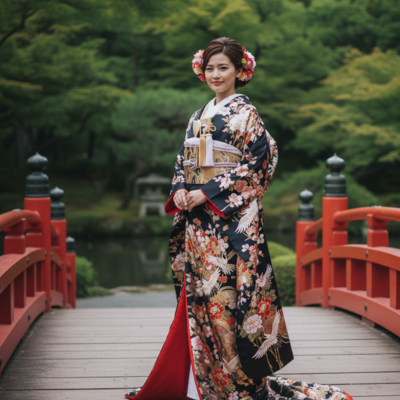
A formal bridal hikifurisode, worn with the hem trailing gracefully on the floor.The obi and accessories are richly coordinated, creating an elegant, regal silhouette reserved for brides.
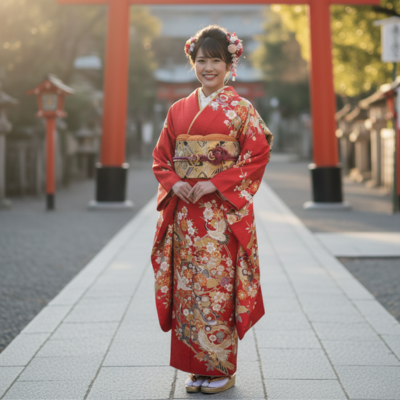
A furisode typically worn for Japan’s Coming-of-Age celebration at age 20.The hem is worn shorter, with the front panel tucked (ohashori) and the overall styling lighter than bridal wear.
【💡A Helpful Tip for Peace of Mind】
Strictly speaking, the coming-of-age furisode is not considered the highest-formal attire for a bride, so it is not typically worn for the wedding ceremony itself.
However, many brides choose to wear their coming-of-age furisode during the reception as an outfit change — and it is a truly beautiful choice.
For many brides, it becomes a heartfelt way to show appreciation to their parents by wearing the furisode they once lovingly prepared for them.
It is often the last opportunity to wear it as an unmarried woman, which makes it deeply meaningful.
Some venues may recommend renting a new bridal kimono instead.
But if you choose to wear your own furisode, consider enhancing it with bridal-specific accessories and a more elaborate obi style to create a luxurious and festive bridal look.
Choosing the Right Kimono for Your Body Type & Venue
The most beautiful kimono is not the one that follows trends,
but the one that truly suits you.
Choosing a style that complements your body type and matches the atmosphere of your wedding venue is the key to feeling confident and avoiding regrets on your special day.
Shiromuku: No Two Whites Are the Same
How to Choose the Perfect Shade for Your Bridal Look
You might think that all shiromuku look the same—
but in reality, each one is unique.
Subtle differences in shade, weaving patterns, and embroidery create a completely different impression depending on who wears it.
The beauty of the shiromuku lies in how its pure white adapts to the bride, revealing her grace and individuality.
| Point | Details |
|---|---|
| Choose by Shade | Shiromuku generally comes in three tones: pure white, off-white, and ivory. Each shade creates a different impression on the face and overall styling. Try on multiple tones to see which white flatters your complexion best. |
| Pattern Size & Balance | For taller brides: Larger, more open patterns create balance and give a graceful, grand impression. For petite brides: Smaller, denser motifs or fine woven designs maintain proportion and bring out an elegant, delicate beauty. |
| Add Personal Style | For a distinctive look, consider shiromuku with subtle red accents on the lining or sleeve edges (aka-fuki). You can also pair it with a colored under-kimono (kakeshita) to add gentle personality while staying traditional. |
Iro-uchikake: Find Your Perfect Match Through Color & Tone
With so many colors and patterns to choose from, it’s easy to feel overwhelmed when selecting an iro-uchikake.
The secret to finding the right one is to first imagine the mood and presence you want to create on your wedding day.
| Point | Details |
|---|---|
| Desired Mood | Think about the feeling you want to express: elegant and mature, soft and romantic, classic and regal, etc. Having a rough image first will help narrow down your choices. |
| Color & Pattern Harmony | Bold colors like gold or black often suit brides with defined facial features, but don’t choose based on base color alone. The pattern greatly affects the impression. Try the kimono on to see which color brightens your complexion and feels harmonious. |
| Pattern Scale | Taller brides: Large, flowing patterns create balance and a majestic presence. Petite brides: Smaller or finely detailed patterns keep proportions elegant and flattering. |
| Venue Harmony | Grand or spacious venues: Large, luxurious patterns with gold or silver accents look stunning even from a distance. Modern venues or indoor settings: Deep tones and chic, modern designs pair beautifully with contemporary architecture and interiors. |
Hikifurisode: Enhance Your Silhouette with Pattern Placement & Accessories
The hikifurisode features a sleek, elegant silhouette,
and by paying attention to accessories and pattern placement, you can further enhance your figure and overall balance.
| Point | Details |
|---|---|
| Pattern Placement | For taller brides: Large patterns with space between motifs create a clean, elegant balance and emphasize height beautifully. For petite brides: Smaller floral motifs or designs with gentle diagonal lines help create a vertical effect, giving a lengthened, graceful silhouette. |
| Obi Color Harmony | Because the obi is visible with a hikifurisode, incorporating colors from the kimono’s patterns into your obi and accessories creates a unified, refined look with a polished finish. |
【💡Helpful Information for Peace of Mind】
“Can I wear a kimono while pregnant?”
You might be surprised, but traditional bridal kimono can often be worn comfortably during pregnancy.
Because the dressing technique allows for adjustable support around the waist and belly, it can be tailored to your body’s needs.
If you’re expecting, simply let your planner and dresser know.
They can help ensure a safe and comfortable fit during your fitting and on the day of the ceremony.
Costs & Budgeting: What You Need to Know to Feel Prepared
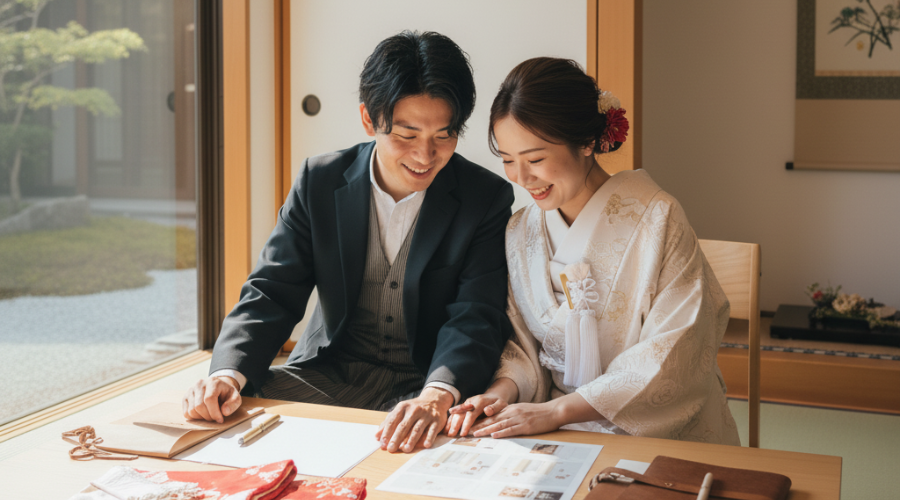
Talking about money may not be the most glamorous part of wedding planning,
but it’s something every bride wonders about.
Because kimono weddings are less common internationally,
it can be harder to understand where the costs come from
compared to Western-style weddings.
Beyond the rental fee for the kimono itself,
there are additional expenses that are easy to overlook—
such as accessories, dressing fees, and outside-vendor charges.
Being aware of these in advance can make all the difference.
In this section, we’ll walk through the typical costs for a kimono wedding
and the key things to check so you can avoid unexpected expenses
and plan with confidence.
Typical Rental Costs for Bridal Kimono
For most brides in Japan, renting a bridal kimono is the standard option.
| Type | Estimated Rental Cost |
|---|---|
| Shiromuku | ¥100,000–¥300,000 (High-end embroidered designs can exceed ¥500,000) |
| Iro-uchikake | ¥150,000–¥450,000 (Luxury brands or artisan-made pieces can be ¥1,000,000+) |
| Hikifurisode | ¥150,000–¥350,000 |
【Why Do Rental Prices Vary So Much?】
The cost of a bridal kimono can differ significantly depending on the density of embroidery, quality of silk, weaving techniques, and whether it is a designer or artisan-made piece.
You may wonder, “Why is it so expensive?” — but hand-crafted kimono made by skilled artisans carry exceptional value and craftsmanship.
Note on “Outside Rental Fees” (Mochikomi-ryō):
If you rent your kimono from a boutique that is not partnered with your venue, the venue may charge an outside-rental fee, typically around ¥50,000–¥100,000 per outfit.
Be sure to confirm this in advance and politely ask whether there is room for negotiation.
Don’t Forget the Extras: Accessories & Hair/Makeup Costs
In addition to the kimono rental itself, it’s important to be aware of a few extra costs that can quietly add up.
Knowing these in advance will help you avoid any “How did it get so expensive?” moments later on.
| Item | Estimated Cost | Details & Notes |
|---|---|---|
| Dressing & Hair/Makeup | Bridal kimono dressing: ¥30,000–¥50,000Hair & makeup: ¥20,000–¥40,000 | Why is this charged separately?Basic dressing and hair/makeup may be included in the rental package, but additional fees often apply if you change hairstyles or redo your look when switching outfits during the day. |
| Accessories | Often included in rental, but upgrades may add cost | Why pay attention here?Essential bridal accessories for shiromuku and iro-uchikake—such as hair ornaments, hakoseko, kaiken, and suehiro—are typically included. However, choosing more luxurious or branded pieces may incur upgrade fees. |
| Photography / Videography | ¥50,000–¥100,000 | Why check this in advance?If you request professional photography or videography during the ceremony, additional fees may apply. Some shrines have restricted access or prohibit photography entirely, so confirm policies beforehand. |
【How to Avoid Unexpected Costs】
Hair and makeup often involve an additional trial (rehearsal) fee, which is not always included in the basic package.
To avoid surprises later, make sure to confirm the following when signing your contract:
- Whether the hair and makeup trial is included or charged separately
- Any additional fees for changing hairstyles during the wedding
- Which accessories and styling items are included in the rental package
Clear communication at the start will help you feel confident and prepared, without unexpected expenses on the big day.
Headpieces & Bouquets: Costs and How to Choose Them
Hair accessories and bouquets play a major role in shaping the overall impression of a kimono bridal look —
but because of that, they can also become surprising extra expenses.
| Item | Average Cost | Notes |
|---|---|---|
| Traditional Wig (Katsura) | ¥40,000–¥50,000 | Prices vary from ¥20,000–¥60,000. Lightweight or fully custom wigs offer superior comfort and fit, but can be significantly more expensive. |
| Wataboshi / Tsunokakushi | ¥8,000–¥10,000 | Simple styles are often included in hair/makeup packages. Special materials like organza may incur additional fees. |
| Kanzashi (Hair Ornaments) | ¥10,000–¥20,000 | Cost varies depending on materials and design. Tortoiseshell-style or coral pieces tend to be pricier when rented. |
| Bouquet for Kimono | ¥10,000–¥30,000 | Brides often choose larger or more structured bouquets to match the kimono’s presence. Price varies depending on whether it’s fresh or artificial flowers. |
Dressing, Beauty Fees & Often-Forgotten Essentials
Dressing and hair/makeup services are often included in the bridal package,
but keep in mind that certain personal items that touch the skin must be purchased separately.
| Item | Estimated Cost | Details & Notes |
|---|---|---|
| Dressing & Hair/Makeup | Bridal dressing: ¥30,000–¥50,000Hair & makeup: ¥20,000–¥40,000 | Usually included in rental packages, but resetting hair for an outfit change or doing a rehearsal may incur additional fees. |
| Juban (Undergarment) | ¥2,500–¥4,000 | A special kimono undergarment worn on the upper body. Regular clothing cannot substitute this, so the proper bridal version is needed. |
| Tabi (Bridal Socks) | ¥1,000–¥2,000 | New tabi socks are typically required for weddings, especially when wearing white formal attire. |
| Susoyoke (Lower Underskirt) | Varies – confirm in advance | A lower-half undergarment worn under kimono. If you already have one from a previous furisode (e.g., Coming-of-Age ceremony), you may be able to use it again. |
Are “Outside Rental Fees” Higher for Kimono?
If you find a kimono you love at a boutique outside your venue’s partner shops,
you will typically be charged an outside rental fee.
Average outside rental fees per outfit
- Bride: ¥20,000–¥50,000 (average: ¥41,309)
- Groom: ¥10,000–¥20,000 (average: ¥23,661)
【Why is there an outside rental fee?】
Many venues operate on a business model where they receive a referral commission from their partnered shops.
Because traditional kimono require special handling, dressing skills, and maintenance,
outside rental fees for kimono are often higher than for Western wedding attire.
If you’re considering bringing in your own outfit,
be sure to confirm whether it’s allowed and what the fee will be before signing your contract.
Preparing to Bring Out the Full Beauty of Traditional Bridal Attire
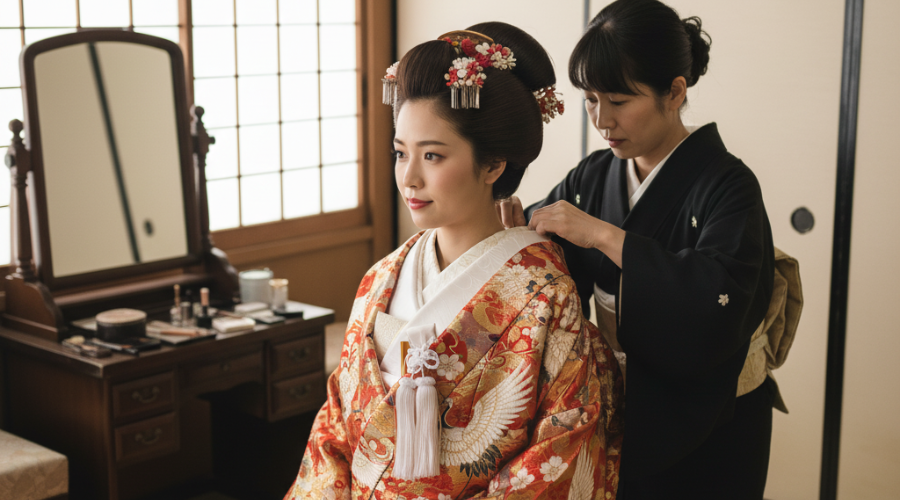
Once you’ve chosen your ideal kimono and feel confident about your budget,
the next step is preparing to present your most beautiful self on the big day.
In this section, we’ll explore how to choose the right hair and makeup,
and the key elements of posture and movement that help you look graceful in traditional attire —
all through the lens of why each point truly matters.
Hair & Makeup: Choosing Styles That Complement Traditional Kimono
There are two main hair styling approaches for a traditional Japanese bridal look:
the classic Bunkin Takashimada wig style and modern Western-style hairstyles.
| Style | Features & Formality | Tips for Choosing |
|---|---|---|
| Bunkin Takashimada | The most formal traditional Japanese bridal hairstyle. Worn with a wig or styled natural hair, often paired with a wataboshi (bridal hood) for a white kimono. | Ideal for brides who want a classic, elegant, and ceremonial look. Proper sizing and fitting of the wig is extremely important for comfort and beauty. |
| Western-style Hair | A modern, softly-styled updo (shin-nihon-kami or contemporary styles). Works well with both uchikake and hiki-furisode. | Creates a softer, natural impression. Perfect for brides who prefer to use their natural hair for a more relaxed, modern finish. |
【💡 Tips for Choosing a Traditional Wig (Katsura)】
While a traditional wig carries the highest level of formality, an ill-fitting size or shape can cause headaches and discomfort on the day.
To keep your celebration flawless, schedule a thorough fitting and adjustment session in advance, and speak up honestly if anything feels even slightly off.
【Why Practice Your Movements?】
The beauty of kimono is completed by the grace of stillness and motion—how you stand, walk, turn, and hold your hands.
Refining these gestures elevates your presence and results in photographs and video that become truly treasured memories.
Conclusion: Creating Your Dream Japanese-Style Bridal Look
As you’ve seen throughout this guide, preparing for a Japanese-style wedding involves learning many cultural details—from understanding the formality of each bridal kimono, to planning your budget, to mastering graceful movements on the big day.
Step by step, with intention and care, you can create a truly unforgettable and regret-free kimono wedding.
One of the most important things is to give yourself time and emotional space.
Make use of the expertise around you—kimono specialists, planners, and hair and makeup artists. With their guidance and your thoughtful preparation, you’ll be able to greet your guests with confidence, grace, and a radiant smile in your chosen ensemble.
Trust your professional team, ask questions whenever you’re unsure, and approach the day with a calm mind.
May this guide support you as you prepare for a once-in-a-lifetime celebration filled with beauty, tradition, and joy.
